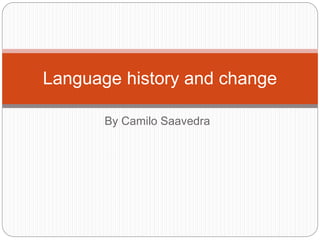Language history and change
•Download as PPT, PDF•
7 likes•6,741 views
PPT presentation about language history and change
Report
Share
Report
Share

Recommended
More Related Content
What's hot
What's hot (20)
Similar to Language history and change
Similar to Language history and change (20)
Evolution of language - Linguistic Changes and Adaptations Over Time

Evolution of language - Linguistic Changes and Adaptations Over Time
More from Camilo Saavedra
More from Camilo Saavedra (20)
Recently uploaded
Recently uploaded (20)
IGNOU MSCCFT and PGDCFT Exam Question Pattern: MCFT003 Counselling and Family...

IGNOU MSCCFT and PGDCFT Exam Question Pattern: MCFT003 Counselling and Family...
Ecosystem Interactions Class Discussion Presentation in Blue Green Lined Styl...

Ecosystem Interactions Class Discussion Presentation in Blue Green Lined Styl...
BAG TECHNIQUE Bag technique-a tool making use of public health bag through wh...

BAG TECHNIQUE Bag technique-a tool making use of public health bag through wh...
Interactive Powerpoint_How to Master effective communication

Interactive Powerpoint_How to Master effective communication
Kisan Call Centre - To harness potential of ICT in Agriculture by answer farm...

Kisan Call Centre - To harness potential of ICT in Agriculture by answer farm...
Measures of Dispersion and Variability: Range, QD, AD and SD

Measures of Dispersion and Variability: Range, QD, AD and SD
Web & Social Media Analytics Previous Year Question Paper.pdf

Web & Social Media Analytics Previous Year Question Paper.pdf
Language history and change
- 1. By Camilo Saavedra Language history and change
- 2. XIX century linguists came up with the idea of the existence of a proto-Indo- european family of languages Languages from different geographical areas have some common features, they are all related. A common ancestor A proto-language, a kind of “Great- grandmother” of modern languages
- 4. Comparative reconstruction A way of finding similarities in different languages (and this way find out their relation to an ancestor), were/are used cognates Cognates are a similar word in one language and another in form or pronounciation Comparative Reconstruction is a process in wich cognates are compared in order to find similarities
- 6. Principles In comparative reconstruction there are two important principles: The majority principle: when comparing cognate sets, the ones more similar demonstrate the less that those languages have changed from the proto- language The natural development principle: are a series of rules in language change (or evolution) that show the antiquity of that language in relation to the proto-
- 7. This shows that the more the word respects these rules, the more similar it is towards the proto-language.
- 8. English language change English language history is divided into three main periods: Old English (VII-XI) Middle English (XI-XV) Modern English (XV-present days)
- 9. Old English Germanic tribes (Angles, Saxons and Jutes) invaded the British Isles in the V century. Words belonging to this period: mann (man), drincan (drink), etan (eat) Then, another northern-european tribe arrived, The Vikings. They brought the Old Norse, words like:
- 11. Viking invasion
- 12. Middle English Normans arrival to the British Isles in 1066. William “The Conqueror” (a norman) was crowned King of England. French relevance during this period, although English never ceased being spoken (by the lower class) Words like: defense, court, faith, army.
- 13. Norman invasion
- 14. From 1400 to 1600 English started changing in form, structure and pronounciation becoming Modern English (more specifically, early modern English)
- 15. Pronounciation change Not only some sounds changed, but also some others disappeared. i.e. the voiceless velar fricative /x/ wich in old english pronounciation of nicht as [nixt], but is absent in the present-day form of night [nayt] Metathesis: is a reversal in two adjoining sounds, had changed the pronounciation of some words
- 17. Prothesis That is the addition of a sound to the beginning of a word
- 18. Syntactic changes In the transition from old english to modern english, we can find several differences in the order of the sentence, i.e.
- 19. Lexical changes A lot of borrowed words have been added to the english language along its evolution, from latin, greek and other languages. New words have been created Some other words have ceased to be used In terms of meaning, there are two processes: Broadening and Narrowing.
- 20. Broadening A word that previously had only one meaning, now it has some others, for example: In old english the word “dogca” was used to refer to any breed of dogs, but now, its evolution “dog” is used to refer to any breed.
- 21. Narrowing Is the reverse process, a word that before had several different meanings or uses, now it has only one, for example: The old english word “mete” refered to any kind of food, now it refers only to a specific breed, “meat”
- 22. It’s worth mentioning that this process of change in the language was not from one day to another, on the contrary a language changes gradually, it takes time and requires some factors to make it possible. Another important point to conclude is that language is in a continuous process of evolution, it’s always changing.
